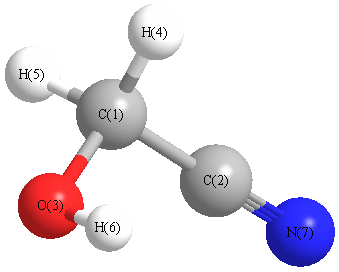Jump to
S1C2
Vibrational Frequencies calculated at CID/cc-pVDZ
Geometric Data calculated at CID/cc-pVDZ
Electronic energy levels
Charges, Dipole, Quadrupole and Polarizability
Jump to
S1C1
Energy calculated at CID/cc-pVDZ
| | hartrees |
|---|
| Energy at 0K | -207.323618 |
| Energy at 298.15K | -207.327091 |
| HF Energy | -206.787291 |
| Nuclear repulsion energy | 102.271844 |
The energy at 298.15K was derived from the energy at 0K
and an integrated heat capacity that used the calculated vibrational frequencies.
Vibrational Frequencies calculated at CID/cc-pVDZ
| Mode Number |
Symmetry |
Frequency
(cm-1) |
Scaled Frequency
(cm-1) |
IR Intensities
(km mol-1) |
Raman Act
(Å4/u) |
Dep P |
Dep U |
|---|
| 1 |
A |
3995 |
3692 |
59.56 |
|
|
|
| 2 |
A |
3241 |
2995 |
6.41 |
|
|
|
| 3 |
A |
3155 |
2915 |
26.11 |
|
|
|
| 4 |
A |
2468 |
2280 |
0.38 |
|
|
|
| 5 |
A |
1538 |
1421 |
1.74 |
|
|
|
| 6 |
A |
1480 |
1368 |
60.18 |
|
|
|
| 7 |
A |
1436 |
1327 |
3.15 |
|
|
|
| 8 |
A |
1274 |
1177 |
15.96 |
|
|
|
| 9 |
A |
1179 |
1090 |
104.58 |
|
|
|
| 10 |
A |
1030 |
952 |
18.80 |
|
|
|
| 11 |
A |
937 |
866 |
22.00 |
|
|
|
| 12 |
A |
607 |
561 |
1.83 |
|
|
|
| 13 |
A |
410 |
378 |
61.80 |
|
|
|
| 14 |
A |
326 |
301 |
89.82 |
|
|
|
| 15 |
A |
226 |
209 |
9.52 |
|
|
|
Unscaled Zero Point Vibrational Energy (zpe) 11651.3 cm
-1
Scaled (by 0.924) Zero Point Vibrational Energy (zpe) 10765.8 cm
-1
See section
III.C.1 List or set vibrational scaling factors
to change the scale factors used here.
See section
III.C.2
Calculate a vibrational scaling factor for a given set of molecules
to determine the least squares best scaling factor.
Geometric Data calculated at CID/cc-pVDZ
Point Group is C1
Cartesians (Å)
| Atom |
x (Å) |
y (Å) |
z (Å) |
|---|
| C1 |
-0.580 |
0.584 |
0.037 |
| C2 |
0.826 |
0.109 |
-0.005 |
| O3 |
-1.504 |
-0.452 |
-0.112 |
| H4 |
-0.715 |
1.149 |
0.971 |
| H5 |
-0.731 |
1.277 |
-0.796 |
| H6 |
-1.404 |
-1.052 |
0.628 |
| N7 |
1.916 |
-0.274 |
-0.015 |
Atom - Atom Distances (Å)
| |
C1 |
C2 |
O3 |
H4 |
H5 |
H6 |
N7 |
| C1 | | 1.4853 | 1.3969 | 1.0994 | 1.0940 | 1.9248 | 2.6400 |
C2 | 1.4853 | | 2.3997 | 2.0994 | 2.1015 | 2.5929 | 1.1549 | O3 | 1.3969 | 2.3997 | | 2.0883 | 2.0142 | 0.9575 | 3.4262 | H4 | 1.0994 | 2.0994 | 2.0883 | | 1.7717 | 2.3314 | 3.1488 | H5 | 1.0940 | 2.1015 | 2.0142 | 1.7717 | | 2.8114 | 3.1660 | H6 | 1.9248 | 2.5929 | 0.9575 | 2.3314 | 2.8114 | | 3.4699 | N7 | 2.6400 | 1.1549 | 3.4262 | 3.1488 | 3.1660 | 3.4699 | |
 More geometry information
More geometry information
Calculated Bond Angles
| atom1 |
atom2 |
atom3 |
angle |
|
atom1 |
atom2 |
atom3 |
angle |
| C1 |
C2 |
N7 |
178.665 |
|
C1 |
O3 |
H6 |
108.222 |
| C2 |
C1 |
O3 |
112.702 |
|
C2 |
C1 |
H4 |
107.700 |
| C2 |
C1 |
H5 |
108.172 |
|
O3 |
C1 |
H4 |
113.016 |
| O3 |
C1 |
H5 |
107.298 |
|
H4 |
C1 |
H5 |
107.749 |
Electronic energy levels
Charges, Dipole, Quadrupole and Polarizability
